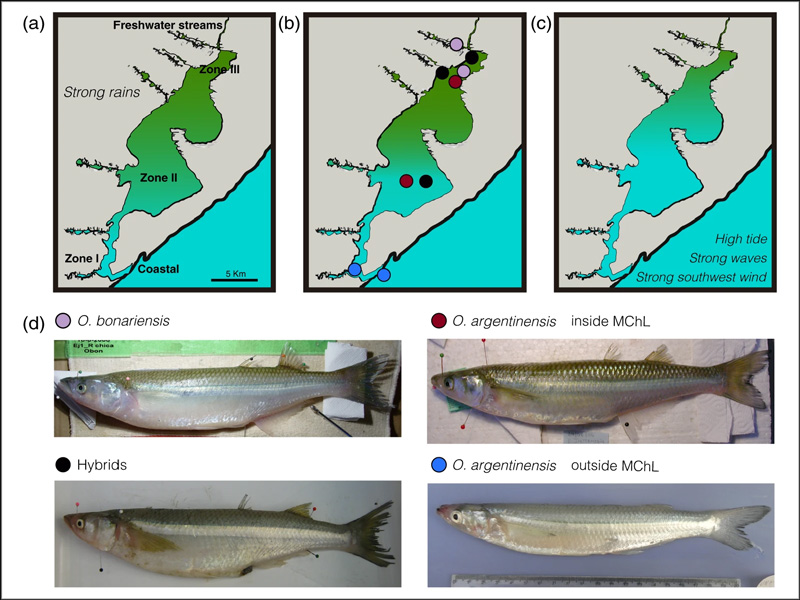Silversides’ Surprising Hybridization
For immediate release ‐ August 05, 2022
Contact: Micah Beasley, 919.707.9970. Images available upon request
 Salinity and species distribution in the Mar Chiquita Lagoon under variable environmental conditions. Image: Yamila P. Cardoso.
Salinity and species distribution in the Mar Chiquita Lagoon under variable environmental conditions. Image: Yamila P. Cardoso.
Summary – Lily C. Hughes, Ph.D., the Museum’s Curator of Ichthyology
In Buenos Aires province, Argentina, the Mar Chiquita Coastal Lagoon is an estuary that has been designated a UNESCO Biosphere Reserve due to its rich biodiversity and remarkable geomorphology. Several species of South American silverside fish reside in and around the lagoon, which is saltwater near the mouth to the Atlantic Ocean, and freshwater where it is fed by streams. Scientists used new genomic, but also morphological, ecological and reproductive data to investigate an interesting interaction between a freshwater silverside species (scientific name: Odontesthes bonariensis) and a marine species (scientific name: Odontesthes argentinensis) inside Mar Chiquita. Fish that appeared to have a mixture of characteristics from both the marine and freshwater species had been documented, but genetic data showed that these fish were hybrids. The genetic data also confirmed that there is a unique population of O. argentinensis that is adapting to the Mar Chiquita Lagoon, which it inhabits year-round. Marine and freshwater species do not often have the opportunity to hybridize, but brackish estuaries can bring these species into contact with each other and create interesting population dynamics. These silversides are popular with fishermen throughout their native range.
Read the full article here: https://www.nature.com/articles/s41437-022-00555-9
Hughes was pleased to collaborate with scientists in Argentina on this research, who have provided a Spanish-language translation of the above text:
Resumen – Mariano González-Castro
En la Provincia de Buenos Aires, Argentina, la Laguna Costera Mar Chiquita es un estuario que ha sido designado como Reserva Mundial de Biosfera por UNESCO, dada su gran biodiversidad y notable geomorfología. Diversas especies de pejerreyes habitan dentro y en los alrededores de dicha laguna, la cual es de agua salada en las cercanías de su desembocadura al mar y dulceacuícola en su interior. Científicos emplearon nuevos datos genómicos, además de datos morfológicos, ecológicos y reproductivos, para investigar una interesante interacción dentro de Mar Chiquita entre el pejerrey dulceacuícola (nombre científico: Odontesthes bonariensis) y el marino (nombre científico: Odontesthes argentinensis). Previamente, se habían documentado peces que parecían tener una mezcla de características de especies marinas y de agua dulce, pero los datos genéticos mostraron que estos peces eran híbridos. La data genética confirmó además que existe una población de O. argentinensis con características únicas, la cual se ha adaptado a la Laguna Mar Chiquita, cumpliendo allí su ciclo de vida. Especies marinas y dulceacuícolas no tienen usualmente oportunidad de hibridar, pero los estuarios tienen la capacidad de poner dichas especies en contacto, creando dinámicas poblacionales interesantes. Estos pejerreyes son populares entre los pescadores en su área de distribución nativa.
For more information about our upcoming activities, conservation news and ground-breaking research, follow @NaturalSciences on Instagram, Twitter and Facebook. Join the conversation with #visitNCMNS.

